
Roasted butternut squash is one of those vegetables that pops into mind when thinking of the Fall Season. Learning how to roast butternut squash makes it an easy ingredient to add to recipes and use to create delicious meals.
Whether you cook it whole, cut it in half, or roast it in cubes, it's a delicious seasonal vegetable you'll enjoy cooking and adding to meals.

Updated: This post was originally published in November 2019 and has been updated with new photos and additional content.
I recommend you explore some of the helpful tips we've added, but you are welcome to jump to the recipe and get cooking. Don't forget to leave a starred rating within the recipe!
Jump to:
💚 Why You'll Love This Recipe
- Roasting in the oven is a reliable and popular cooking method for this winter squash.
- Perfect for meal prep. Roast it up and then store it to use in meals in the future!
- Great way to cook this veggie to use later in savory and sweet preparations.
🛒 Ingredients

- Butternut squash: Found in local markets and farmer's markets in the fall and winter months while in large grocery stores, it's often available year-round.
- Extra virgin olive oil: One of my favorite healthy oils for cooking. I don't know if you would want to add some other options for oil here!
- Maple syrup: Adding a bit of maple syrup when roasting this veggie enhances its natural sweetness.
- Sea salt: Balances the sweetness of the squash and syrup.
How do you select butternut squash?
When you're at the store searching for the perfect one to buy, you are going to use a few of your senses to choose the perfect one.
- Visual: It's important to select one that is solid matte beige without any cuts and bruises. Also, look for a stem that is brown, intact, and firm to touch.
Choose one with a longer neck than a bulb at the end. The bulb end (rounded part) is hollow and where the seeds are located while the neck is the part you can simply slice and cube up more easily.
- Touch: Pick it up and feel its weight. If it feels hard and heavy for its size, it should be perfectly ripe. Try comparing other butternut squashes in the batch, and you will be able to judge it better.
- Listen: Tap on the side and if it sounds like it is hollow inside, it is not ready to eat!
When you bring it home, store it in a cool, dark place away from any sunlight where it may continue to ripen. It can last for up to a couple of months after you bring it home from the store.
Can I use other types of winter squash?
While the butternut squash is the sweetest of the winter squash varieties you can swap it with other winter squash including butternut, buttercup, Hubbard, sugar pumpkin, and acorn squash.
The flavors and textures of these other types of squash may vary slightly. Also, some of these squash have even more difficult peels and may work best when roasted whole or cut in half.
What's the best seasoning for roast butternut squash?
I love the simplicity of cooking it with maple syrup and salt, but you can get creative and consider these flavors too when preparing it for meals.
- Chiles
- Cinnamon
- Garlic
- Nutmeg
- Nuts
- Onions
- Sage
- Balsamic vinegar
- Apples
- Coconut milk
✅ Step-By-Step Instructions
How To Roast Butternut Squash
Butternut squash is part of the winter squash family which typically has a tough outside peel and firm inside which requires a bit more effort to cut than summer squash.
- Place the butternut squash on your cutting board.
- Cut off the ends first, which creates a flat side to use for standing the squash up. This makes it safer to cut.
- Then use a chef's knife to cut the outer skin off. You can also use a peeler if you prefer.
- Separate the bulb section from the neck. Slice the neck to whatever thickness you prefer for your recipe.

TOP TIP: For the bulb side, I cut as close to where the seeds are and then cut that section into cubes. You can also slice the squash in half, scoop out the seeds, and then cut it into cubes. Now you've got all the squash cut up into pieces and ready to cook.
Now that the squash is prepped and ready to go, you can get started roasting it in the oven. To start, preheat the oven and line your baking sheet with parchment paper.
- Cut the slices into cubes.
- Place the cubes in a large mixing bowl.
- Add the maple syrup, olive oil, and sea salt and stir until the cubes are completely coated.
- Transfer it to a baking sheet and roast in the oven for 45 minutes.
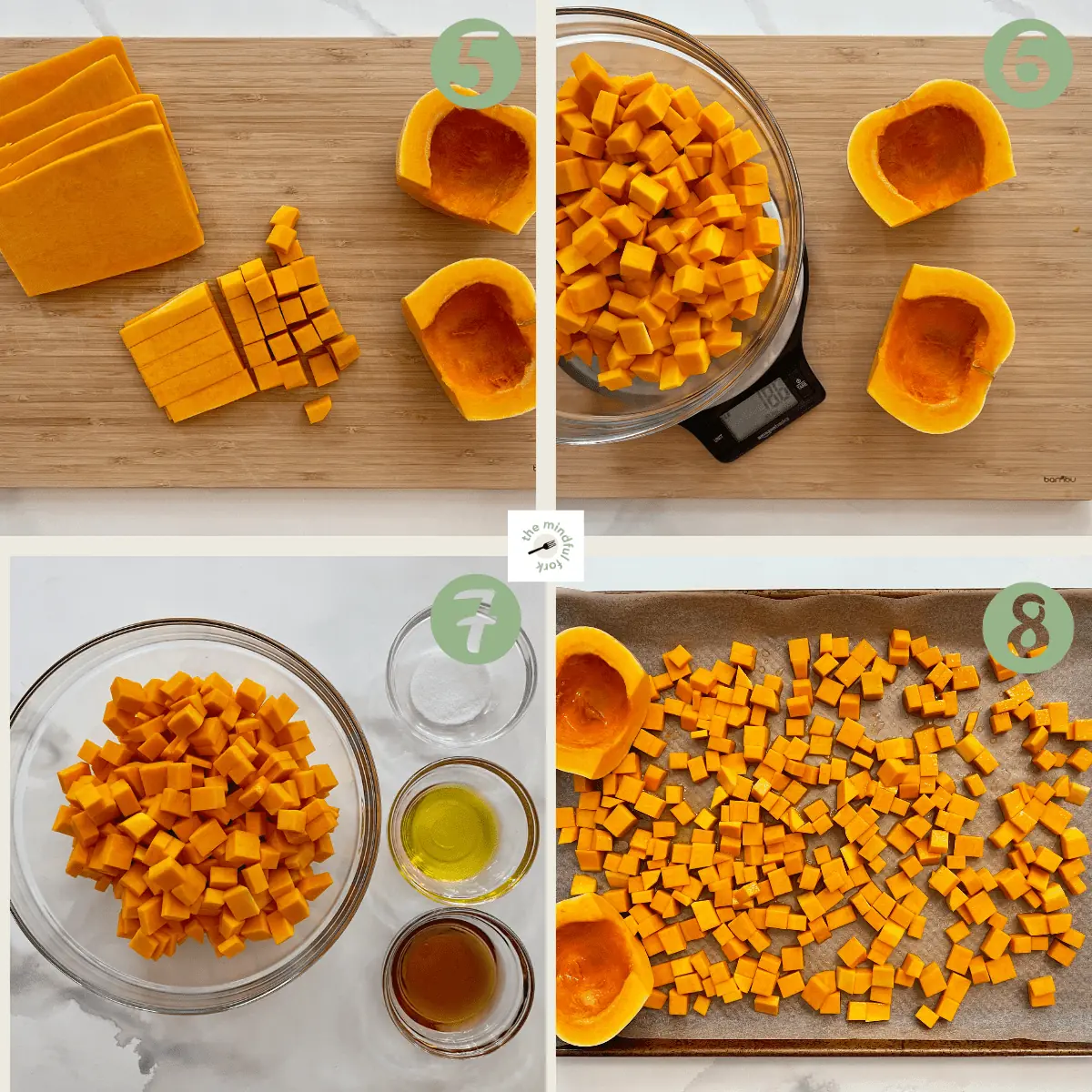
When the butternut squash is finished roasting, measure out the amount you need for your recipe and get cooking! The best thing about this preparation is you can use the leftover squash for other recipes.
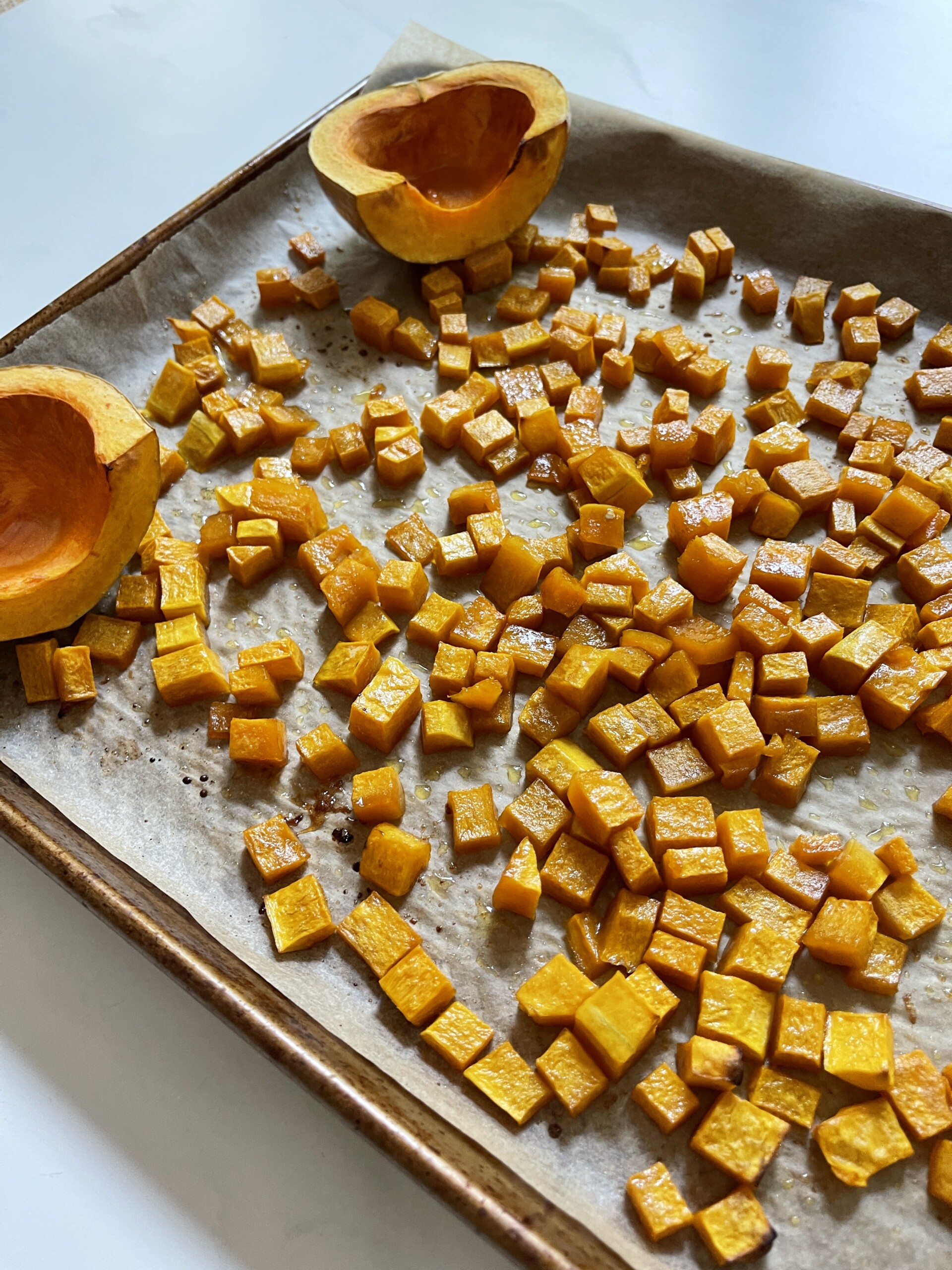
🍽 How to Serve
You can serve up roasted butternut squash as a tasty side dish all on its own or use it to prepare other recipes.
- As a side dish, it goes well with a Roasted Cauliflower Steak or as a side for a sandwich, veggie burger, or Collard Green Wraps.
- For soups and stews, try using it to make a Pureed Butternut Squash Soup or use it as an ingredient to make homemade chili.
- Add it to salads or grain bowls such as this Pear and Pecan Salad or this Butternut Squash and Quinoa Salad.
- Use it as a filling for wontons or as a savory sauce for mac and cheese.
🌿 Seasonal Variations
These days, butternut squash and other winter squash are at the height of their season in the colder winter months, but you can usually find them year-round in most stores and some markets.
❄️ How to Store
Make ahead: It's perfect for making ahead. After cooking, allow it to cool completely before storing it in airtight containers. Store it in the fridge for up to five days or in the freezer for up to three months.
Thaw and Reheat: When you're ready to use it, allow it to thaw out in the fridge overnight. Add thawed butternut squash to recipes as desired. To serve it as a side dish, you can transfer it to an oiled roasting pan and heat it in a 350° F oven until heated. This will take about 10-15 minutes.
🔪 Helpful Kitchen Tools & Gadgets
Here are a few of my favorite eco-friendly kitchen tools which come in handy when making this recipe.
- Chef's knife for cutting ease.
- Cutting board that's eco-friendly and won't dull your knife.
- Containers for storage of leftovers.
- Sheet pan and Silpat for even roasting and easy clean-up.
Check out TMF's Resources for guidance on purchasing eco-friendly tools, gadgets, ingredients, and more!
♻️ Zero-Waste Tips
- Don't throw out the seeds! You can actually use roasted butternut squash seeds. Separate them out from the pulp and rinse. Let them dry a bit and then toss with some oil and roast in the oven. They make a crunchy topping for salads or eat them on their own for a snack.
- Save extras or freeze. It's perfect for the freezer!
- Use up the extras to make your favorite recipes. My favorite ways to use it are in salads and to make chili!
❓FAQ
Yes, you can. You can cut it in half and cook it with the cut side down or cook it whole. This is great for recipes that require it mashed or puréed. I typically pierce the skin with a fork or knife to allow the steam to rise from the squash as it cooks. Roast the squash in a 350° F oven for 45-60 minutes. It's done when a fork can easily pierce the skin and flesh. Allow it to cool and then scoop it from the skin.
Yes, cooking squash in the air fryer is quick and easy. Follow all the same instructions in this recipe and pop the cubes in a 375-degree air fryer for 10 to 12 minutes. You can adjust the timer for your desired crispiness.
🌎 Sustainability Suggestions
Component cooking is the idea of using products that are in season to create a meal that isn't recipe driven but rather uses food building blocks that are combined to create a meal.
This vegetable can be roasted ahead of time and then transformed through its use in many different recipes. Component cooking allows you to get creative with your ingredients and is also a great way to reduce food waste!

More Squash Recipes
If you made this recipe, please leave a star 🌟 rating on the recipe card right below! You can also drop a review in the comment section. Your feedback is appreciated! And don’t forget to tag @themindfulfork so we can see your creations.
📖 Recipe

How to Roast Butternut Squash
Ingredients
- 1 butternut squash approximately 3 pounds (6 cups cut into cubes)
- 2 tablespoons maple syrup
- 2 tablespoons extra virgin olive oil
- ½ teaspoon sea salt
Instructions
- Preheat oven to about 375°
- Line a baking sheet with parchment paper
- Place the cubes in a large mixing bowl (approximately 6 cups)
- Measure and mix in 2 tablespoons maple syrup, 2 tablespoons extra virgin olive oil, and ½ teaspoon sea salt
- Stir until completely coated and then place on baking sheet
- Roast for approximately 45 minutes
Notes
- Don't throw out the seeds! Separate them out from the pulp and rinse. Let them dry a bit and then toss with some oil and roast in the oven. They make a crunchy topping for salads or eat them on their own for a snack.
- Save extras or freeze. It's perfect for the freezer!
- Use up the extras to make your favorite recipes. My favorite ways to use it are in salads and to make chili!

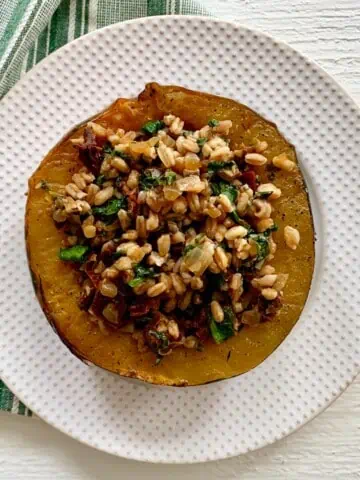
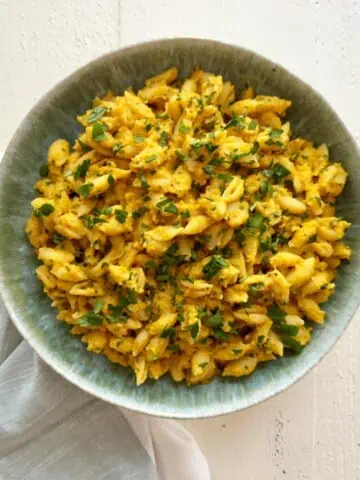
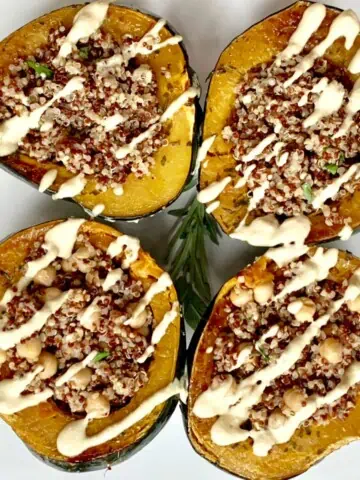
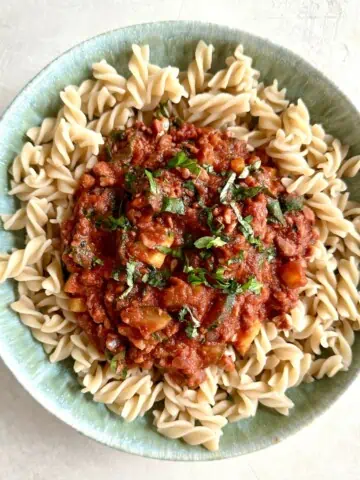
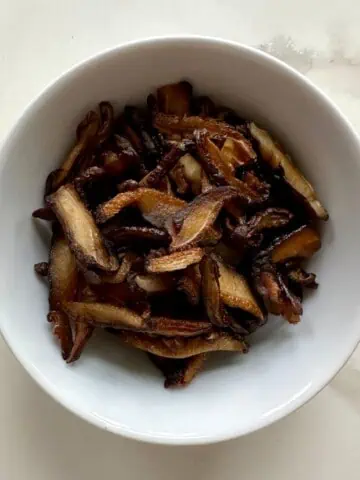
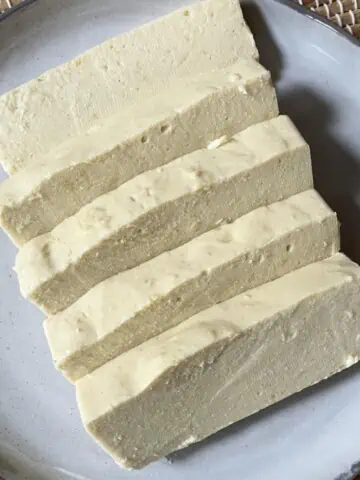
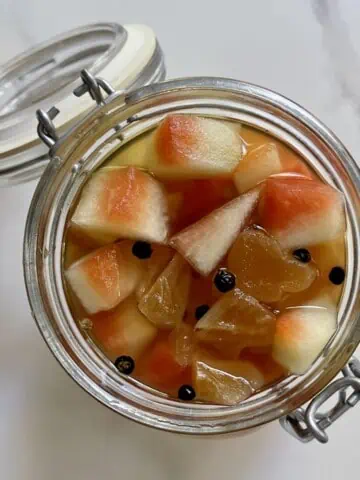
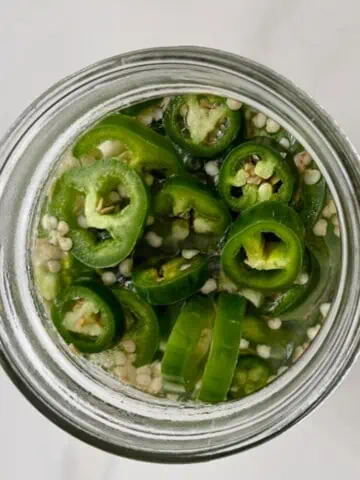
Comments
No Comments